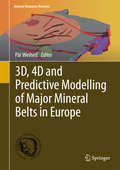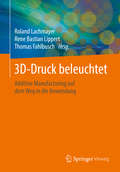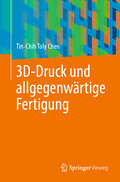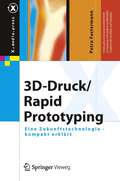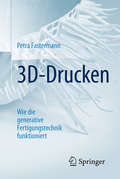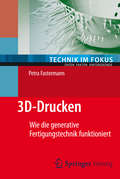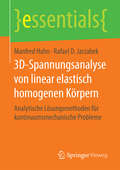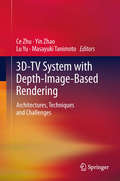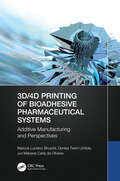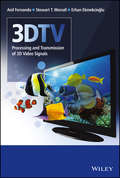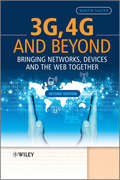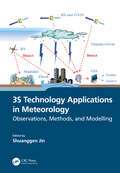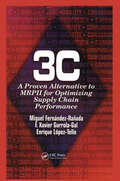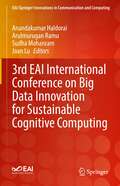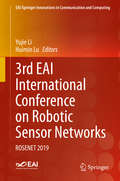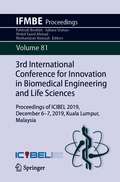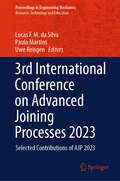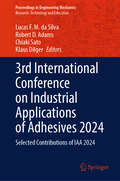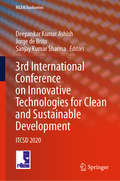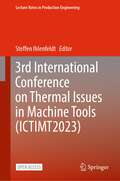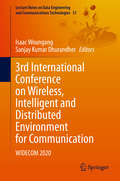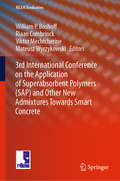- Table View
- List View
3D, 4D and Predictive Modelling of Major Mineral Belts in Europe (Mineral Resource Reviews)
by Pär WeihedThis book presents the results of the major EU project Promine. For the first time there is now a European database available on mineral deposits, as well as 3D, 4D and predictive models of major mineral belts in Europe: Fennoscandia (Skellefteå and Vihanti-Pyhäsalmi), the Fore-Sudetic basin (Kupferschiefer deposits in Poland and Germany), the Hellenic belt in northern Greece, and the Iberian Pyrite belt and Ossa Morena zone in Spain and Portugal. The book also describes the modelling techniques applied and how different types of software are used for three- and four-dimensional modelling. Furthermore, fundamental descriptions of how to build the database structure of three-dimensional geological data are provided and both 2D and 3D predictive models are presented for the main mineral belts of Europe.
3D-Druck beleuchtet: Additive Manufacturing auf dem Weg in die Anwendung
by Roland Lachmayer Rene Bastian Lippert Thomas FahlbuschDas vorliegende Buch zeigt einen Überblick über das breite Anwendungsfeld des Additive Manufacturing, mit dem Fokus auf den industriellen Einsatz unterschiedlicher Technologien. Nach der Beschreibung eines allgemeinen Grundverständnisses und der Einschätzung zur Nutzung von Additive Manufacturing Verfahren in der Produktentwicklung werden verschiedene Technologien hinsichtlich von Nachhaltigkeits-, Individualisierungs-, Qualifizierungs- und Gestaltungsaspekten analysiert. Dabei liegt der Fokus stets auf der Betrachtung der gesamten Prozesskette, vom Pre-Prozess über den In- und Post-Prozess bis hin zur Anwendung. Die abschließende Betrachtung von Sicherheitsmerkmalen des Additive Manufacturing resultiert in der Einschätzung zukünftiger Entwicklungen im Bereich des Additive Manufacturing.
3D-Druck und allgegenwärtige Fertigung
by Tin-Chih Toly ChenDieses Buch bietet einen umfassenden Überblick über die Anwendungen von 3D-Drucktechnologien in der allgegenwärtigen Fertigung (Ubiquitous Manufacturing, UM). UM selbst stellt eine Anwendung des Ubiquitären Computings im Fertigungssektor dar, und dieses Buch zeigt, wie es bequemen, bedarfsgerechten Netzwerkzugang zu einem gemeinsamen Pool konfigurierbarer Fertigungsressourcen, einschließlich Software-Tools, Ausrüstung und Fähigkeiten, bietet. Aufgrund seines Umfangs wird das Buch für Forscher in den Bereichen Fertigung, Maschinenbau, Betriebsmanagement, Produktionssteuerung, Ubiquitäres Computing und Sensortechnologien sowie für praktizierende Manager und Ingenieure von großem Interesse sein.
3D-Druck/Rapid Prototyping: Eine Zukunftstechnologie - kompakt erklärt (X.media.press)
by Petra FastermannImmer mehr Kreative nutzen die Möglichkeit, eigene dreidimensionale Objekte in Kunststoff, Metall oder Keramik schnell und preisgünstig herstellen zu lassen. Der 3D-Druck ist eine revolutionäre Technologie, die dieVerwirklichung von Ideen ermöglicht. 3D-Drucker werden immer kleiner und leistungsstärker und damit bürotauglicher. Eine umfassende Beschreibung dieser Zukunftstechnologie bietet dieses praxisnahe und anwenderorientierte Buch. Dabei hilft es mit Tipps und Hinweisen bei der Auswahl des optimalen CAD-Programms und 3D-Druckers.
3D-Drucken: Wie die generative Fertigungstechnik funktioniert (Technik im Fokus)
by Petra FastermannDas 3D-Drucken entwickelt sich rasant. L#65533;ngst ist der 3D-Druck f#65533;r Interessierte eine Fertigungs-Technologie, die sie selbst nutzen m#65533;chten. Doch welche M#65533;glichkeiten bietet 3D-Druck? Welche neuen Entwicklungen gibt es? Wie hat sich 3D-Druck etabliert? Was ist in den letzten Jahren selbstverst#65533;ndlich geworden? Was ist verbessert worden? Mit der zweiten, #65533;berarbeiteten und aktualisierten Auflage beantwortet die Autorin diese Fragen. Die 3D-Druck-Technologie wird - auch f#65533;r Nicht-Techniker - verst#65533;ndlich erkl#65533;rt. Hinweise auf kostenlose 3D-CAD-Software-Programme und weiterf#65533;hrende Literatur laden dazu ein, das Gelesene zu vertiefen und selbst anzuwenden.
3D-Drucken: Wie die generative Fertigungstechnik funktioniert (Technik im Fokus)
by Petra FastermannWie funktioniert 3D-Druck? Wofür eignet sich welche 3D-Druck-Technologie? Was bedeutet 3D-Druck für den Einzelnen? Welche gesellschaftlichen und wirtschaftlichen Veränderungen wird es durch diese Zukunftstechnologie geben? Die Autorin gibt Antworten auf diese Fragen. Sie führt präzise und einfach in die immer populärer werdende Technologie des 3D-Drucks ein. Die Leser werden so in den Stand versetzt, 3D-Druck selbst anzuwenden. Sie lernen, kostenlose Software auszuprobieren oder vielleicht sogar in einer der immer zahlreicher werdenden offenen Werkstätten (FabLabs) einen 3D-Drucker selbst zu nutzen.
3D-Spannungsanalyse von linear elastisch homogenen Körpern: Analytische Lösungsmethoden für kontinuumsmechanische Probleme (essentials)
by Manfred Hahn Rafael D. JarzabekManfred Hahn und Rafael D. Jarzabek stellen zwei neue analytische 3D-Lösungen in der Kontinuumsmechanik vor. Diese analytischen Lösungen können zur Verifikation von numerischen Lösungsmethoden herangezogen werden. Beginnend wird in diesem essential die geschichtliche Entwicklung der analytischen Lösungsmethoden in der Kontinuumsmechanik für den 2D- und 3D-Raum und die daraus entstandenen Probleme aufgeführt. Da die Weiterentwicklung der analytischen Methoden aufgrund der mathematischen Schwierigkeiten vor einigen Jahrzehnten stagnierte und die Anwender numerische Methoden wegen der Entwicklung des Computers bevorzugten, wurden fortwährend nur noch numerische Lösungen für spezielle Probleme berechnet. Heute ist die Mathematik aber weiter, sodass nun doch neue analytische Lösungen gefunden werden können. Dazu stellen die Autoren die ursprünglichen Lösungsansätze vor und vergleichen sie mit dem neuen Lösungsverfahren von Pagano.
3D-TV System with Depth-Image-Based Rendering: Architectures, Techniques and Challenges
by Masayuki Tanimoto Ce Zhu Lu Yu Yin ZhaoRiding on the success of 3D cinema blockbusters and advances in stereoscopic display technology, 3D video applications have gathered momentum in recent years. 3D-TV System with Depth-Image-Based Rendering: Architectures, Techniques and Challenges surveys depth-image-based 3D-TV systems, which are expected to be put into applications in the near future. Depth-image-based rendering (DIBR) significantly enhances the 3D visual experience compared to stereoscopic systems currently in use. DIBR techniques make it possible to generate additional viewpoints using 3D warping techniques to adjust the perceived depth of stereoscopic videos and provide for auto-stereoscopic displays that do not require glasses for viewing the 3D image. The material includes a technical review and literature survey of components and complete systems, solutions for technical issues, and implementation of prototypes. The book is organized into four sections: System Overview, Content Generation, Data Compression and Transmission, and 3D Visualization and Quality Assessment. This book will benefit researchers, developers, engineers, and innovators, as well as advanced undergraduate and graduate students working in relevant areas.
3D/4D Printing of Bioadhesive Pharmaceutical Systems: Additive Manufacturing and Perspectives
by Marcos Luciano Bruschi Denise Tiemi Uchida Mariana Carla de OliveiraThis book features a brief history of additive manufacturing and 3D/4D printing techniques, as well as the advantages, applications, and overall challenges facing the technology. It then focuses on the applications of bioadhesive systems for drug delivery.3D/4D Printing of Bioadhesive Pharmaceutical Systems: Additive Manufacturing and Perspectives, explores recent discoveries of 3D printing in the development of pharmaceutical systems and drug delivery. Specifically, it discusses the main polymers/materials used in the development of bio-adhesive pharmaceutical systems and explains the importance of bio-adhesiveness of drug release through 3D printing. The authors also introduce the main strategies necessary to achieve a proper drug delivery system through 3D printing, and examine the adhesiveness of these systems on the skin as the mucosa decreases with the elimination of the drug by the body. Finally, the book brings all the necessary specifications to obtain a bioadhesive system with suitable bio-ink to obtain the best 3D/4D printing.This book is written with the objective of helping students start their studies in pharmaceutical engineering, bioengineering and additive manufacturing. Moreover, engineering professionals can use the book to improve the performance of 3D/4D printers for this type of system.
3DTV
by Erhan Ekmekcioðlu Stewart T. Worrall Anil FernandoA novel and timely primer to the 3DTV system chain from capture to displayThis book examines all aspects of the 3DTV chain, from capture to display. It helps the reader learn about the key issues for 3DTV technology. It also provides with a systems level appreciation of 3DTV systems, and an understanding of the fundamental principles behind each part of the chain. At the end of each chapter, the author provides resources where readers can learn more about the technology covered (e.g. more focused text books, key journal papers, and key standards contributions).Provides a fundamental and systematic introduction and description of 3DTV key techniques, which build up the whole 3DTV system from capture to consumer viewing at the home.Addresses the quick moving field of 3D displays which is attracting increasing interest from industry and academia.Concepts in the book will be illustrated using diagrams and example images of processed 3D content. The 3D content will be presented as 2D images in the book.Authors to host website providing pointers to more information on the web, freely available tools which would enable readers to experiment with coding video, simulate its transmission over networks, play it back in 3D, and measure the quality and links to important news and developments in the field.
3G, 4G and Beyond: Bringing Networks, Devices and the Web Together
by Martin SauterExtensively updated evaluation of current and future network technologies, applications and devices This book follows on from its successful predecessor with an introduction to next generation network technologies, mobile devices, voice and multimedia services and the mobile web 2.0. Giving a sound technical introduction to 3GPP wireless systems, this book explains the decisions taken during standardization of the most popular wireless network standards today, LTE, LTE-Advanced and HSPA+. It discusses how these elements strongly influence each other and how network capabilities, available bandwidth, mobile device capabilities and new application concepts will shape the way we communicate in the future. This Second Edition presents a comprehensive and broad-reaching examination of a fast-moving technology which will be a welcome update for researchers and professionals alike. Key features: Fully updated and expanded to include new sections including VoLTE, the evolution to 4G, mobile Internet access, LTE-Advanced, Wi-Fi security and backhaul for wireless networks Describes the successful commercialization of Web 2.0 services such as Facebook, and the emergence of app stores, tablets and smartphones Examines the evolution of mobile devices and operating systems, including ARM and x86 architecture and their application to voice-optimized and multimedia devices
3S Technology Applications in Meteorology: Observations, Methods, and Modelling
by Shuanggen JinSpatial information technology and its integration, such as remote sensing, geographic information systems (GIS), and global navigation satellite systems (GNSS), known as 3S technology, have been extensively utilized in managing and monitoring natural disasters. This book illustrates the 3S integrated applications in the field of meteorology and promotes the role of 3S in developing precise and intelligent meteorology. It presents the principles of 3S technology and the methods for monitoring different meteorological disasters and hazards as well as their application progress. The case studies from the United States, Japan, China, and Europe were conducted to help all countries understand the 3S technology functions in handling and monitoring severe meteorological hazards. FEATURES Presents integral observations from GNSS, GIS, and remote sensing in estimating and understanding meteorological changes Explains how to monitor and retrieve atmospheric parameter changes using GNSS and remote sensing Shows three-dimensional modelling and evaluations of meteorological variation processing based on GIS Helps meteorologists develop and use space-air-ground integrated observations for meteorological applications Illustrates the practices in monitoring meteorological hazards using space information techniques and case studies This book is intended for academics, researchers, and postgraduate students who specialize in geomatics, atmospheric science, and meteorology, as well as scientists who work in remote sensing and meteorology, and professionals who deal with meteorological hazards.
3c: A Proven Alternative to MRPII for Optimizing Supply Chain Performance
by F Xavier Gurrola-Gal Miguel Fernandez-Ranada Enrique Lopez-TelloLack of materials or goods to satisfy customer orders under current market conditions represents an extremely costly and important problem facing businesses today. This is a problem that companies have spent hundreds of millions of dollars trying to solve. This book introduces a new theory, 3C, which will solve these problems. The authors, experts from Lucent Technologies, discuss in detail the relationship between the 3Cs - capacity, commonality, and consumption - and how this relationship can revolutionize your business. You will learn how to: reduce overhead expense and improve shipping performance by using the business capacity as the basis for materials planning; reduce investments in inventory by using the commonality of components; obtain dramatic improvements in the lead time of customer orders by using the actual consumption of materials instead of inaccurate sales forecasts as the basis for purchasing. The new and exciting techniques based on 3C generate immediate business benefits, for example: executing the purchasing function with a new criteria and formulae that can eliminate material shortages and significantly improve shipping performance, sales volumes, operating expense and company image.3C-A Proven Alternative to MRPII for Optimizing Supply Chain Performance gives you the knowledge and practical guidelines to better manage end-to-end Supply Chains and eliminate the expensive and annoying problem of material shortages that most businesses suffer.Features
3rd EAI International Conference on Big Data Innovation for Sustainable Cognitive Computing (EAI/Springer Innovations in Communication and Computing)
by Anandakumar Haldorai Arulmurugan Ramu Sudha Mohanram Joan LuThis book features the proceedings of The EAI International Conference on Big Data Innovation for Sustainable Cognitive Computing (BDCC 2020), which took place 18 – 19 December 2020. The papers feature detail on cognitive computing and its self-learning systems that use data mining, pattern recognition and natural language processing (NLP) to mirror the way the human brain works. This international conference focuses on technologies from knowledge representation techniques and natural language processing algorithms to dynamic learning approaches. Topics covered include Data Science for Cognitive Analysis, Real-Time Ubiquitous Data Science, Platform for Privacy Preserving Data Science, and Internet-Based Cognitive Platform.
3rd EAI International Conference on IoT in Urban Space (EAI/Springer Innovations in Communication and Computing)
by Helena Rodrigues Kristof Van Laerhoven Rui JoséThis proceedings presents the papers from Urb-IoT 2018 - 3rd EAI International Conference on IoT in Urban Space, which took place in Guimarães, Portugal on 21-22 November 2018. The conference aims to explore the emerging dynamics within the scope of the Internet of Things (IoT) and the new science of cities.The papers discuss fusion of heterogeneous urban sources, understanding urban data using machine learning and mining techniques, urban analytics, urban IoT infrastructures, crowd sourcing techniques, incentification and gamification, urban mobility and intelligent transportation systems, real time urban information systems, and more. The proceedings discuss innovative technologies that navigate industry and connectivity sectors in transportation, utility, public safety, healthcare, and education. The authors also discuss the increasing deployments of IoT technologies and the rise of the so-called 'Sensored Cities'‚ which are opening up new avenues of research opportunities towards that future.
3rd EAI International Conference on Robotic Sensor Networks: ROSENET 2019 (EAI/Springer Innovations in Communication and Computing)
by Huimin Lu Yujie LiThis proceedings presents the papers of the 3rd EAI International Conference on Robotic Sensor Networks (ROSENET 2019). The conference explores the integration of networks and robotic technologies, which has become a topic of increasing interest for both researchers and developers from academic fields and industries worldwide. The authors posit that big networks will be the main approach to the next generation of robotic research, The book discusses how the explosive number of network models and increasing computational power of computers significantly extends the number of potential applications for robotic technologies while also bringing new challenges to each network's community. The conference provided a platform for researchers to share up-to-date scientific achievements in this field. The conference took place August 17, 2019, Kitakyushu, Japan.Presents the proceedings of the 3rd EAI International Conference on Robotic Sensor Networks (ROSENET 2019), August 17, 2019, Kitakyushu, JapanFeatures papers on robotic technologies for healthcare, medicine, military and moreIncludes perspectives from a multi-disciplinary selection of global researchers, academics, and professionals
3rd International Conference for Innovation in Biomedical Engineering and Life Sciences: Proceedings of ICIBEL 2019, December 6-7, 2019, Kuala Lumpur, Malaysia (IFMBE Proceedings #81)
by Fatimah Ibrahim Juliana Usman Mohd Yazed Ahmad Norhamizan HamzahThis book presents innovative engineering solution for medical diagnosis, therapy and life science studies. Gathering the proceedings of the 3rd International Conference for Innovation in Biomedical Engineering and Life Sciences, ICIBEL 2020, held on December 6-7, 2019, in Kuala Lumpur, Malaysia, this book aims at informing on engineering tools and their clinical applications, and being a source of inspiration for future research and interdisciplinary collaborations.
3rd International Conference on Advanced Joining Processes 2023: Selected Contributions of AJP 2023 (Proceedings in Engineering Mechanics)
by Lucas F. M. da Silva Paulo Martins Uwe ReisgenThis book provides selected contributions of the 3rd International Conference on Advanced Joining Processes, held in Braga, Portugal, on October 19–20, 2023. The volume is dedicated to the current developments in mechanical joining (1st Section), joining by plastic deformation (2nd Section), and welding (3rd Section). The selected contributions represent the state of the art in advanced methods of joining. The book serves as a reference volume for researchers and graduate students working with advanced joining processes.
3rd International Conference on Industrial Applications of Adhesives 2024: Selected Contributions of IAA 2024 (Proceedings in Engineering Mechanics)
by Robert D. Adams Chiaki Sato Lucas F. M. da Silva Klaus DilgerThis book offers selected papers presented at the 3rd International Conference on Industrial Applications of Adhesives, held in Cascais, Portugal, March 7-8, 2024. The goal of the conference was to provide a unique opportunity to exchange information, present the latest results as well as to discuss issues relevant to industrial applications of adhesives. Special contributions on formulation of adhesives, pressure sensitive adhesives, adhesive properties, design of adhesive joints, and durability of adhesive joints have been selected for this volume. This work will appeal to a wide readership, from practitioners through graduate students to researchers working in this field.
3rd International Conference on Innovative Technologies for Clean and Sustainable Development: ITCSD 2020 (RILEM Bookseries #29)
by Jorge De Brito Deepankar Kumar Ashish Sanjay Kumar SharmaThis book gathers peer-reviewed contributions presented at the 3rd International Conference on Innovative Technologies for Clean and Sustainable Development, held in Chandigarh, India, on February 19-21, 2020. The respective papers focus on sustainable materials science and cover topics including the durability and sustainability of concrete, green materials in construction, economics of cleaner production, environmental impact mitigation, innovative materials for sustainable construction, performance and sustainability of special concrete, renewable energy infrastructure, sustainability in road construction, sustainable concrete, sustainable construction materials, waste minimization & management, prevention and management of water pollution, and zero-energy buildings.
3rd International Conference on Thermal Issues in Machine Tools (Lecture Notes in Production Engineering)
by Steffen IhlenfeldtThis open access conference proceedings contains all the papers presented at the ICTIMT 2023, the 3rd International Conference on Thermal Issues in Machine Tools. The event takes place in Dresden, the capital of Saxony, from March 21-23 2023. The conference is organized by the Chair of Machine Tools Development and Adaptive Controls of the Technische Universität Dresden.
3rd International Conference on Wireless, Intelligent and Distributed Environment for Communication: WIDECOM 2020 (Lecture Notes on Data Engineering and Communications Technologies #51)
by Isaac Woungang Sanjay Kumar DhurandherThis book presents the proceedings of the 3rd International Conference on Wireless Intelligent and Distributed Environment for Communication (WIDECOM 2020), sponsored by Ryerson University, Toronto, Canada, May 6-8, 2020. The WIDECOM conference solicits papers addressing issues related to new dependability paradigms, design, and performance of dependable network computing and mobile systems, as well as issues related to the security of these systems. The goal of the conference is to provide a forum for researchers, students, scientists and engineers working in academia and industry to share their experiences, new ideas and research results in the above-mentioned areas.Presents the proceedings of the International Conference on Wireless Intelligent and Distributed Environment for Communication (WIDECOM 2020), Ryerson University, Toronto, Canada, May 6-8, 2020;Includes an array of topics networking computing, mobile/ubiquitous systems, cloud systems, and IoT systems;Addresses issues related to protecting information security and establishing trust in the digital space.
3rd International Conference on the Application of Superabsorbent Polymers (RILEM Bookseries #24)
by Viktor Mechtcherine William P. Boshoff Riaan Combrinck Mateusz WyrzykowskiThe book gathers the peer-reviewed contributions presented at the 3rd International Conference on Application of Superabsorbent Polymers (SAP) and Other New Admixtures towards Smart Concrete, held in Skukuza, South Africa, on November 25-27, 2019. It features papers focusing on the behavior of SAP in concrete (in particular the absorption behavior) as well as the effect of SAP on fresh and hardened concrete properties. It also covers topics such as other modern admixtures, in particular rheology-modifying admixtures, including the recently emerging field of bio- or waste-derived admixtures. The conference builds on the experience and summarizes the activities of the RILEM Technical Committee 260-RSC "Recommendations for Use of Superabsorbent Polymers in Concrete Construction" and addresses other prominent research activities in the field of concrete admixtures.
3rd International Congress on Energy Efficiency and Energy Related Materials: Proceedings, Oludeniz, Turkey, 19–23 October 2015 (Springer Proceedings in Energy)
by Ahmet Yavuz Oral Zehra Banu Bahsi OralThe 3rd International Congress on Energy Efficiency and Energy Related Materials (ENEFM2015) was held from 19-23 October 2015. This congress focused on the latest developments of sustainable energy technologies, materials for sustainable energy applications and environmental and economic perspectives of energy. These proceedings included 40 peer-reviewed technical papers, submitted by leading academic and research institutions from over 23 countries and represented some of the most cutting-edge researches available. The sections included in the 40 papers are listed as follows: Solar Energy, Fuel cells, Hydrogen productions, Hydrogen storage, Energy storage, Energy saving, Biofuels and Bioenergy, Wind Energy, Nuclear Energy, Fossil Energy, Hydropower, Carbon capture and storage, Materials for renewable energy storage and conversion, Photovoltaics and solar cells, Fuel generation from renewables (catalysis), Carbon dioxide sequestration and conversion, Materials for energy saving, Thermoelectrics, Energy saving in buildings, Bio-Assessment and Toxicology, Air pollution from mobile and stationary sources, Transport of Air Pollutants, Environment-Friendly Construction and Development, Energy Management Systems.
3rd International Symposium of Space Optical Instruments and Applications: Beijing, China June 26 - 29th 2016 (Springer Proceedings in Physics #192)
by H. Paul Urbach Guangjun ZhangThis volume contains selected and expanded contributions presented at the 3rd Symposium on Space Optical Instruments and Applications in Beijing, China June 28 - 29, 2016. This conference series is organised by the Sino-Holland Space Optical Instruments Laboratory, a cooperation platform between China and the Netherlands. The symposium focused on key technological problems of optical instruments and their applications in a space context. It covered the latest developments, experiments and results regarding theory, instrumentation and applications in space optics. The book is split across five topical sections. The first section covers space optical remote sensing system design, the second advanced optical system design, the third remote sensor calibration and measurement. Remote sensing data processing and information extraction is then presented, followed by a final section on remote sensing data applications.
